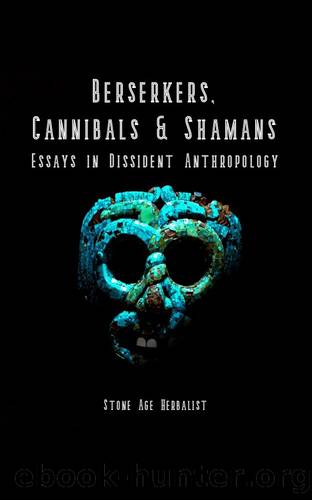Berserkers, Cannibals & Shamans: Essays in Dissident Anthropology by Stone Age Herbalist

Author:Stone Age Herbalist
Language: eng
Format: azw3
Published: 2022-08-24T04:00:00+00:00
On The Origin Of Writing - Part One
Proto-writing - From Lascaux to Rongorongo
This mini-series, on the origins of writing, was guest written by a good friend. His anonymous nom de plume is Pygmy Glottochronologist, and he can be found musing on languages most arcane at @GreatValueArhat on Twitter.
If any common thread can be said to weave our corner of the internet together, itâs a keen interest in prehistory. The desire to peer into the time before time is strong in all of us, though we indulge it in the way that best suits our own form- archaeology, genetics, linguistics, even artistic expression. Those of you who know me will know me as a linguistics sperg, an appellation I suppose I began to bring upon myself in early childhood when my curiosity was first piqued by my familyâs sojourns across North America, coming across Spanish, French, Cherokee, Yiddish, Amharic, among others. Thus, when it came time to plunge into the sands of time in which we all swim in my own idiom, language was my diving-board. My search for the voices of our forebears have led me down many winding paths- scattered in files on my desktop are dissertations on hypothetical Saami subrates, PDFs of Ainu dictionaries, and memes bemoaning the publicâs lack of interest in the honey-gathering vocabulary of the Baka pygmies.
Of course, what separates the murky realm of prehistory we strangely sort of explore for recreation and the proper history of our grade-school social studies textbooks is inextricably related to language- specifically, to writing. Itâs quite a strange concept, writing, and perhaps weâd be more inclined to realize this were our modern lives not so dependent upon it. Youâre certainly too far away for me to speak with, and yet here you are, perhaps thousands of miles away and years after I write these words, and yet I am talking to you. The writings of those who came long before us and who are now long gone enable them to speak to us, if not with us, still today. Itâs in this way that history begins- we know of Egypt, China, and Rome because we were written of Egypt, China, and Rome- we know little of the Independence I culture of northern Greenland for this exact inverse reason.
But what differentiates the wealth of information that weâve been able to glean from the corpus of Egyptian or Akkadian writing from the petroglyphs of the American Southwest or the famous cave art of Lascaux? These latter two are also markings on a physical medium- why do they not yield the same information as the former? The answer is that they are not writing- not âproperâ writing- and not for the considerations of cultural or historical merit. No, they arenât writing for a very simple reason- they encode ideas and concepts, but not language.
Carvings, drawings, or other such markings are known in linguistics and archaeology as proto-writing. Rather than serving as a visual (or tactile, in the case of Braille) representation of
Download
This site does not store any files on its server. We only index and link to content provided by other sites. Please contact the content providers to delete copyright contents if any and email us, we'll remove relevant links or contents immediately.
| Archaeology | Essays |
| Historical Geography | Historical Maps |
| Historiography | Reference |
| Study & Teaching |
Underground: A Human History of the Worlds Beneath Our Feet by Will Hunt(11308)
Sapiens by Yuval Noah Harari(4601)
Navigation and Map Reading by K Andrew(4583)
Barron's AP Biology by Goldberg M.S. Deborah T(3655)
The Sympathizer by Viet Thanh Nguyen(3559)
5 Steps to a 5 AP U.S. History, 2010-2011 Edition (5 Steps to a 5 on the Advanced Placement Examinations Series) by Armstrong Stephen(3420)
Three Women by Lisa Taddeo(2941)
The Comedians: Drunks, Thieves, Scoundrels, and the History of American Comedy by Nesteroff Kliph(2807)
Water by Ian Miller(2620)
Drugs Unlimited by Mike Power(2210)
DarkMarket by Misha Glenny(1866)
The House of Government by Slezkine Yuri(1864)
The Library Book by Susan Orlean(1752)
A Short History of Drunkenness by Forsyth Mark(1749)
Revived (Cat Patrick) by Cat Patrick(1694)
The Woman Who Smashed Codes by Jason Fagone(1666)
And the Band Played On by Randy Shilts(1648)
The House of Rothschild: Money's Prophets, 1798-1848 by Niall Ferguson(1633)
Birth by Tina Cassidy(1585)
